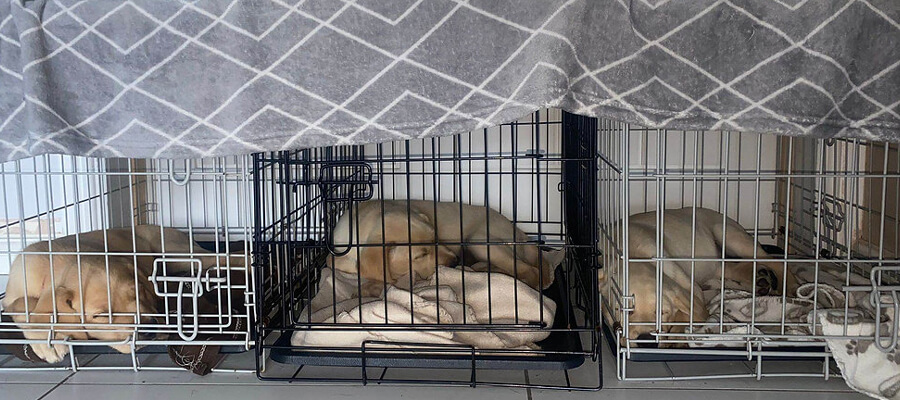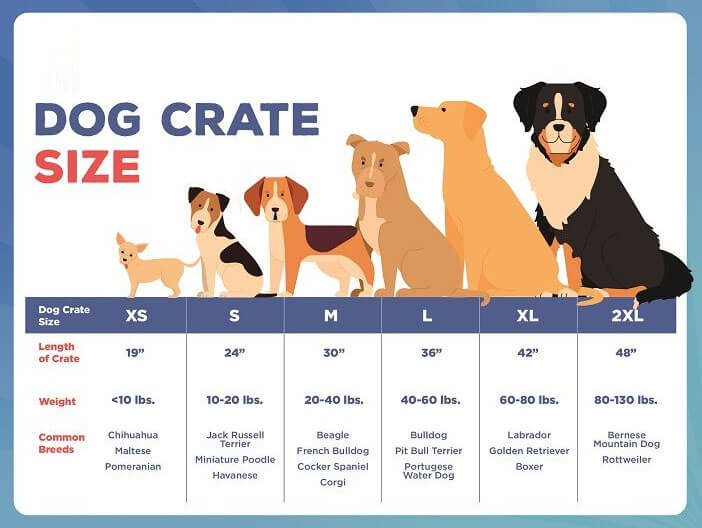
How to Choose the Right Dog Crate for Your Pet
Choose the Right Dog Crate for Comfort and Security
A dog crate is an essential tool for many dog owners, providing a safe and comfortable space for their pets, whether it's for training, travel, or as a quiet retreat within the home. However, choosing the right dog crate can be a bit overwhelming, given the variety of options available. To help you make the best choice for your dog, we’ll guide you through the factors to consider when selecting the perfect crate for your pet.
Why Use a Dog Crate
Before diving into the specifics of choosing a crate, let’s briefly discuss why crates are beneficial for both dogs and owners:
- Safety and Security: A crate provides a safe environment for your dog, both at home and while traveling. It can prevent destructive behavior and reduce the risk of accidents when you're not around.
- Training Tool: Crates are commonly used for house training, as dogs tend to avoid soiling their sleeping area. It helps establish a routine for potty breaks and learning proper behavior.
- Travel Comfort: A crate offers a comfortable and familiar space for your dog during car rides or air travel, helping to reduce anxiety and making transport safer.
- A Personal Space: Many dogs enjoy having their own private retreat within the home. A crate can be a calming space where they can go to relax and rest undisturbed.
Factors to Consider When Choosing a Dog Crate
Here are the key factors to consider when choosing the right dog crate for comfort and security for your dog
1. Size: Getting the Right Fit Dog Crate Size by Breed
The most important factor when choosing a crate is ensuring it’s the right size for your dog. A crate that’s too small can feel cramped and uncomfortable, while one that’s too large can cause your dog to use one part of the crate as a bathroom.
Essentials for Your Newly Adopted Pet
Welcoming a shelter pet into your life is a beautiful journey. Here are some handpicked items to help your new friend feel safe, loved, and right at home:
- Length and Width: Measure your dog from the tip of their nose to the base of their tail, and from the floor to the top of their head. The crate should be long enough for them to lie down fully stretched out, and tall enough for them to stand and turn around comfortably.
-
Crate Size Guidelines:
- Small Crates: For small breeds like Chihuahuas or Yorkies (typically up to 20 lbs).
- Medium Crates: For breeds like Beagles, Cocker Spaniels, or French Bulldogs (typically 20-40 lbs).
- Large Crates: For breeds like Labrador Retrievers, Golden Retrievers, or German Shepherds (typically 40-70 lbs).
- Extra Large Crates: For giant breeds like Great Danes, Mastiffs, or Saint Bernards (over 70 lbs).
It’s important to get a crate that is big enough for your dog to move around in, but not so large that it loses its calming effect.

2. Type of Crate: Wire, Plastic, or Soft-Sided
There are several types of crates, each offering different advantages:
-
Wire Crates:
- Best for: Versatility, ventilation, and ease of cleaning.
- Why It’s Great: Wire crates are durable and provide excellent airflow, which is particularly useful in warmer environments. They often have a removable tray for easy cleaning and fold flat for storage or transport.
- Cons: Less portable and may not provide as much privacy, which some dogs prefer.
-
Plastic Crates (Airline-Approved Crates):
- Best for: Travel and a more enclosed, private space.
- Why It’s Great: Plastic crates are ideal for travel, especially if you're flying. They’re sturdy and offer more privacy, making them great for dogs who prefer enclosed spaces.
- Cons: They can be less ventilated than wire crates and may be harder to clean.
-
Soft-Sided Crates:
- Best for: Portability and dogs who prefer a cozier, more den-like feel.
- Why It’s Great: Soft-sided crates are lightweight and easy to transport, making them perfect for short trips or taking your dog to the vet. They’re also comfortable and offer more flexibility in terms of storage.
- Cons: Not ideal for strong or anxious dogs, as they can be chewed through or collapsed easily.
3. Crate Material: Durability and Safety
Different materials offer different levels of durability:
- Wire Crates: Typically made from coated steel or metal, they are strong and resistant to damage. They may rust over time, especially if exposed to moisture, so ensure they are stored in a dry area.
- Plastic Crates: Made from hard plastic, they offer a sturdy and safe environment, especially for travel. They are more likely to be chewed by strong dogs, so consider your dog’s temperament.
- Soft-Sided Crates: Usually made from fabric with a sturdy frame. While they’re convenient and comfortable, they’re not as durable and are more suitable for calmer dogs.
4. Crate Features: Comfort and Convenience
Consider the features that will make both you and your dog comfortable with the crate:
- Removable Tray: Crates with removable trays make cleaning up accidents much easier. A simple wipe-down or washing can keep the crate fresh.
- Collapsible Design: Many wire crates can fold flat, making them easy to store and transport. This is especially important if you need to travel with your dog or store the crate when not in use.
- Locking Mechanisms: Choose a crate with secure, sturdy locks to ensure your dog cannot accidentally escape. Double-door designs offer more flexibility for placement in your home.
- Divider Panels: Some wire crates come with divider panels, allowing you to adjust the space as your dog grows, making it a great choice for puppies.
- Padded Mats or Bedding: A soft bed or blanket inside the crate makes it a more comfortable space. Be sure the bedding is easy to clean and durable enough for your dog’s activity level.
5. Crate for Travel vs. Home Use
The intended use of the crate will influence the type you choose:
- For Travel (Airline Approved Crates): If you're planning on flying with your dog, look for a crate that is specifically designed for air travel and meets airline regulations. These crates are typically made of plastic and have ventilation holes and secure locking mechanisms.
- For Home Use: For regular home use, a wire crate or soft-sided crate might be more suitable, depending on whether you need to fold and store it or if your dog prefers a more enclosed space.
How to Train Your Dog to Use a Crate
Once you’ve chosen the right crate, it’s time to get your dog used to it. Here are some tips for crate training:
- Introduce the Crate Gradually: Place the crate in a common area of your home, like the living room. Let your dog explore it at their own pace, without forcing them inside.
- Make It Comfortable: Add a blanket or mat to the crate to make it feel cozy and inviting. You can also place a favorite toy or chew inside to encourage them to enter.
- Feed Meals in the Crate: Start feeding your dog their meals inside the crate. This will create positive associations with the crate.
- Practice Short Periods: Begin by closing the door for short periods while you’re in the room, gradually increasing the time. Use treats and praise to reward calm behavior.
- Never Use the Crate as Punishment: Always ensure that your dog sees the crate as a positive space, never as a form of punishment.
Conclusion: Choosing the Right Crate for Your Dog
Choosing the right dog crate is essential for your dog’s comfort, safety, and well-being. By considering your dog’s size, temperament, and intended use of the crate, you can make an informed decision. Whether you choose a wire crate, plastic crate, or soft-sided option, remember to make the crate a positive, secure, and comfortable environment for your dog. With patience and training, your dog will quickly learn to love their crate, and it will become a useful tool for both you and your furry friend.
Affiliate Products
We may earn a small commission when you shop through our links — it helps us keep sharing love and care for every dog out there, at no extra cost to you.
Up to 75% Discount

Dog Collar with Health Monitoring
BUY NOW »
Up to 55% Discount

Luxury Faux Furhuge Napping Bed
BUY NOW »

